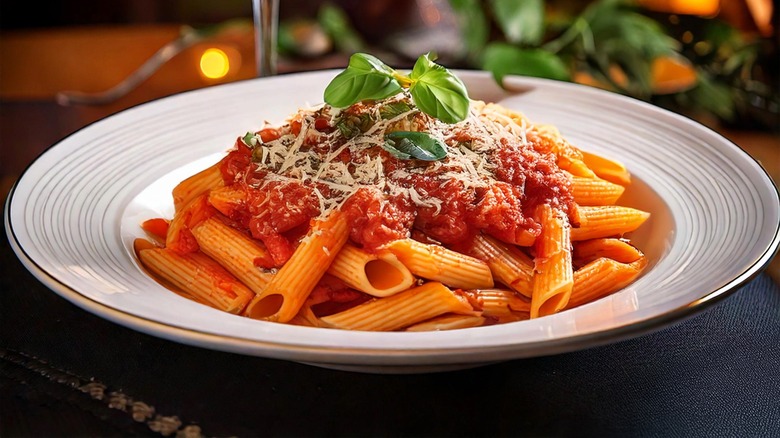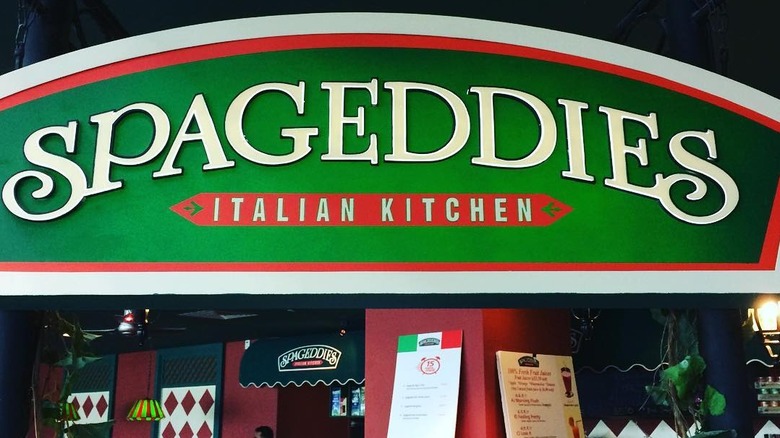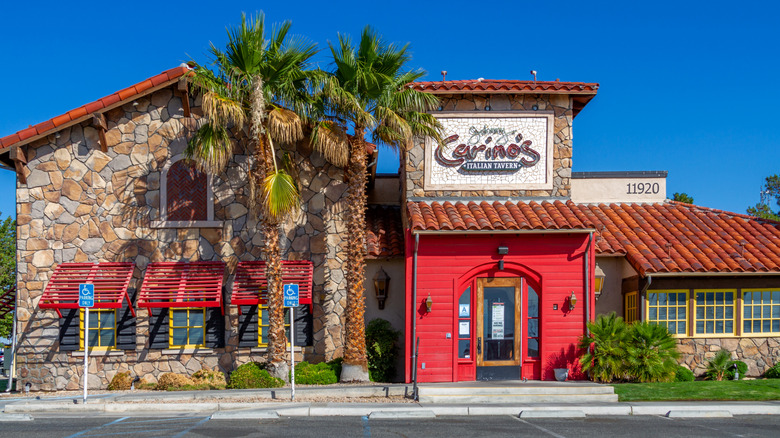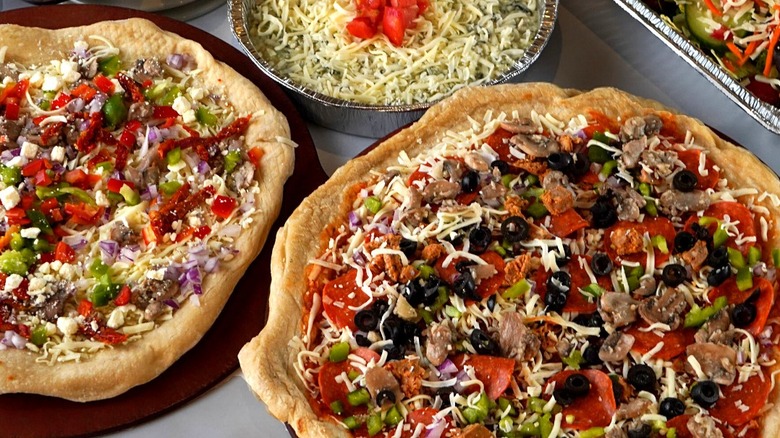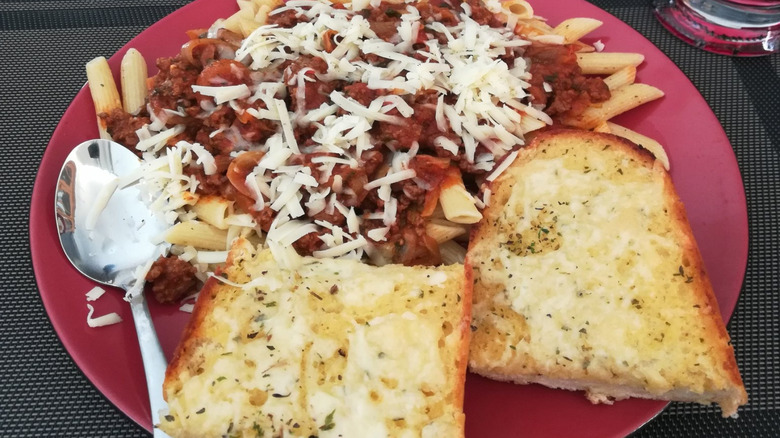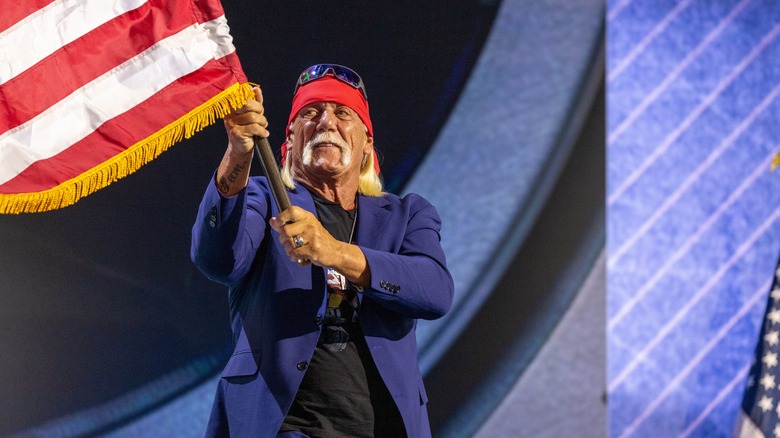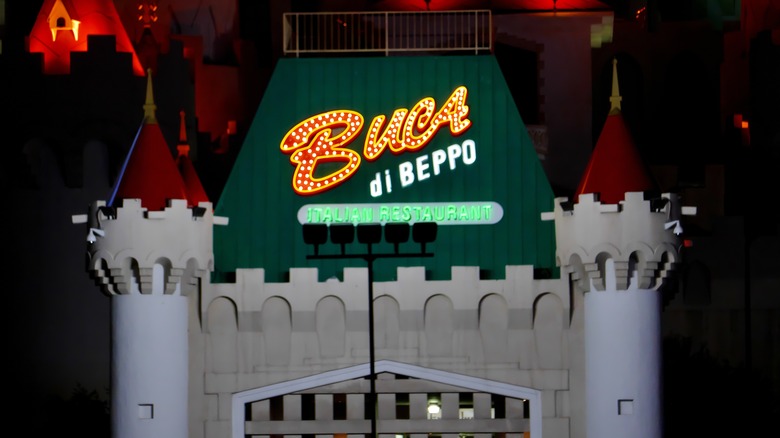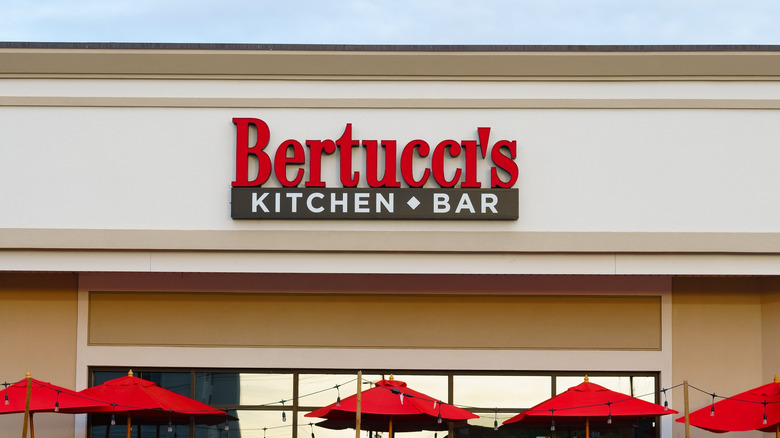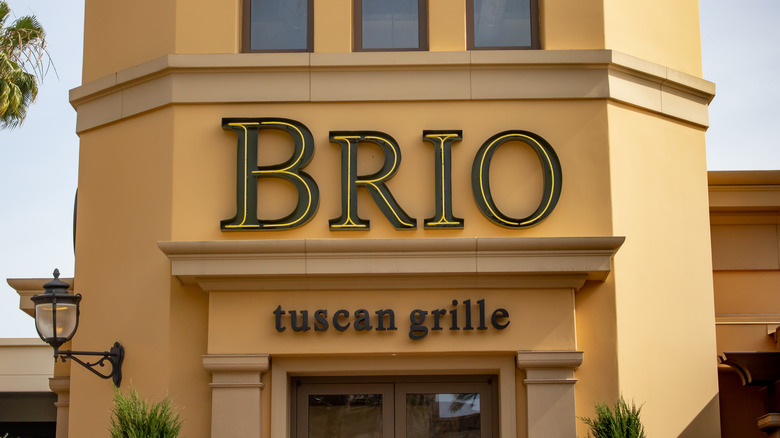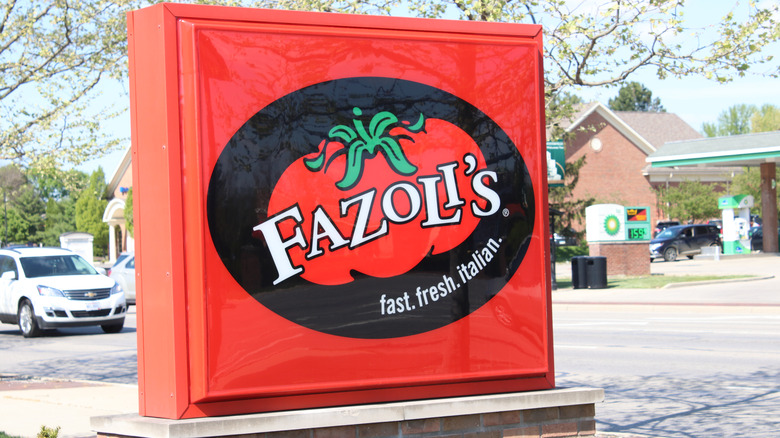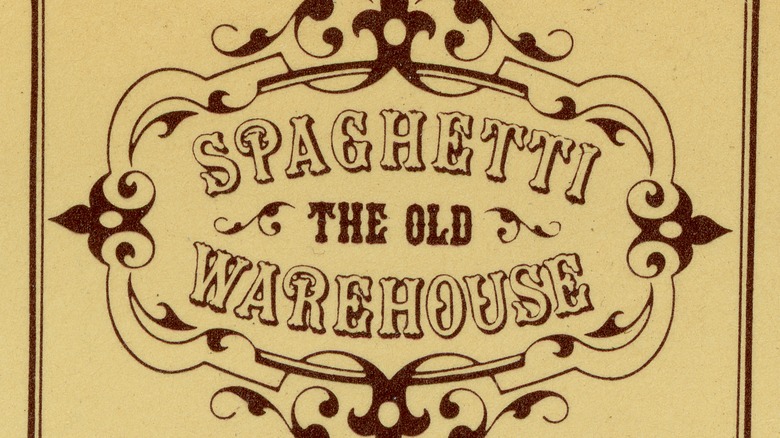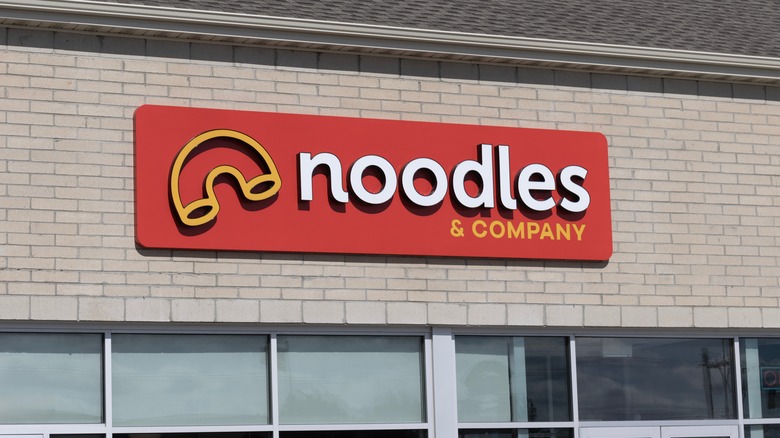Nostalgic Italian Restaurant Chains That Have Faded Away
Is there anything more comforting than a giant bowl of pasta? Well, maybe knowing that you won't have to move afterwards as you slowly digest all those carbs like a python devouring its prey. That's probably why a good plate of spaghetti and meatballs has become a staple of American comfort food and a frequent feature on many restaurant menus. That's also why, starting in the 1960s, we saw a steady stream of new Italian restaurant chains trying to become a staple of our weekly food budget.
But despite the cuisine's popularity in America, many classic Italian restaurant chains have struggled to survive in today's economy. So many of the chains that we enjoyed in the 20th century are either closed or seemingly on the way to disappearing for good, with only a handful of surviving restaurants left to carry on their names. That includes these 12 Italian chains, all of which have faded away in recent years but still have the ability to make us long for a giant bowl of affordable pasta and unlimited breadsticks. Were they always authentic? Not really, especially since there are a lot of Italian-American menu items that aren't from Italy at all. But they were tasty and filling, and isn't that what really matters at the end of the day?
Spageddies
This fast-casual Italian chain was created in 1992 by Brinker International, the company behind Chili's. The Spageddies menu focused on huge portions, offering pasta in either regular or giant family-sized bowls. While the chain started with a single restaurant in Plano, Texas, it soon grew to a lineup of 16 locations by 1995. That's when the rights to Spageddies were sold to Quality Dining, Inc., along with the much larger Grady's American Grill chain. The new owners ended up growing the brand further, even opening up international locations in Singapore and Indonesia. However, over the next couple of decades, the stores started closing around the world, with the last Spageddies, located in Lafayette, Indiana, closing in 2020.
But while Spageddies is gone for good, Quality Dining went on to develop a new restaurant chain called Papa Vino's Italian Kitchen, which has three locations in Michigan and Indiana. It may not offer Spageddies' giant pasta bowls, but it does offer a slightly more rustic (and probably slightly more authentic) Italian taste.
Johnny Carino's
Johnny Carino's was named after a real-life Johnny Carino, who previously served as the corporate chef at Spageddies' parent company, Brinker International. Like Spageddies, one of Johnny Carino's main selling points was its large portions, with the menus boasting that you could get a family-sized serving for the same price as a solo meal. It also featured slightly more rustic-looking decor and a slightly more authentic menu, which might explain why it ended up being more successful than its competitor.
At its peak in 2006, there were 173 Johnny Carino's in 30 states. As well as pasta, it served up the likes of minestrone soup (which happened to end up on our list of the healthiest items to order at an Italian restaurant, albeit with a slight caveat about its sodium content). However, the chain's success didn't last. Its parent company, Fired Up Inc., was forced to file for bankruptcy in 2014, only to have to file for it again in 2016. That time, its owner blamed the situation on the poor fast-casual dining market, but also on low oil prices, higher marketing costs, and higher health costs from the Affordable Care Act. While the company hasn't dipped back into bankruptcy since that second occurrence, it's currently down to only 25 locations, mostly in California and Texas.
Zio's Italian Kitchen
Zio's Italian Kitchen is another chain that's gone through multiple bankruptcies. Its restaurants offer plenty of pasta dishes, like spaghetti and lasagna, as well as a range of brick-fired pizzas. One of its most unique items has to be its Italian Toothpicks, which were fried flour tortillas filled with Italian sausage, pepperoni, bacon, red pepper, spinach, and cheese, then fried and served with marinara sauce, creating something that sounds like a cross between flautas and Hot Pockets.
The chain managed to grow to 16 restaurants in six states by 2016, when it went bankrupt. Food Management Partners — a company tied to the rise and fall of Don Pablo's, the well-known Mexican chain — has since managed to keep the chain alive. Or at least, it did until February 2025, when Zio's declared bankruptcy again, which it blamed on a 10% drop in business over the past year.
However, you can still find Zio's Italian Kitchen restaurants open for business throughout the country. Just don't get your heart set on trying those Italian Toothpick appetizers, as they've long since disappeared from the menu.
Pasta Bravo
Pasta Bravo (not to be confused with Bravo!, a different Italian chain we'll talk about later) was a quick-casual chain based in Irvine, California. The chain offered a range of gourmet pizzas, along with single-serving pasta dishes like chicken basil cream and spaghetti and meatballs. Founded in 1988, the chain grew to encompass 16 restaurants in Southern California.
There was enough interest in the chain that Yum! Brands bought the rights to the concept in 2003 for $5 million. The company planned to combine the stores with its existing Pizza Hut locations, and even opened a co-branded Pizza Hut and Pasta Bravo store in Tennessee later that year. But that planned expansion never went through. By 2011, Pasta Bravo had closed all its locations, with the last one being the original location in Irvine, California.
The founder of Pasta Bravo, Tim Aspel, went on to create a grilled seafood chain called Spike's Fish House. In 2012, he explained to the Orange County Register why Pasta Bravo didn't succeed. "Over the years, people's tastes have gone from carbs to proteins," he said. "Fresh, healthy seafood works."
Hulk Hogan's Pastamania
The only wrestling-themed restaurant on this list (or, indeed, most lists), Hulk Hogan's Pastamania, was a short-lived pasta restaurant endorsed by the famous wrestler. The menu definitely seemed tailored to the food court crowd, with mix-and-match pasta combos where customers could choose from angel hair, shells, nuggets, fettuccine, and penne, combined with their choice of sauces such as marinara, pesto, white clam, or garlic and oil. There was also a section of more complex dishes, such as beef stroganoff, turkey tetrazzini, and Swedish meatballs. The kids' menu even featured a unique dish known as Hulkios, which was basically just pieces of pasta shaped like Hulk Hogan.
Pastamania opened in 1995 at the Mall of America and was promoted by a special episode of "WCW Monday Nitro," hosted by Hogan, Randy "Macho Man" Savage, and Jimmy Hart. But despite all the publicity, that ended up being the only Pastamania restaurant to open — and even that one closed within a year. However, there must be a horde of passionate Pastamaniacs out there today, as Hogan sold off an autographed Pastamania shirt for $5,000. Man, that would've bought a lot of Hulkios back in the day.
Buca di Beppo
One of the most surprising entries on this list is probably Buca di Beppo, which seemed to be doing really well in recent memory. Founded in 1993 in Minneapolis, Minnesota, the chain is known for its large family-sized plates and kitschy decor, featuring vintage photos and bric-a-brac on the walls celebrating Italian-American culture. (If you're curious about the name, Buca di Beppo roughly translates to "Joe's small place," or "Joe's basement," a reference to the first restaurant in the chain, which was in the basement of an apartment building.)
By 2001, the Buca di Beppo chain had grown to 68 locations in 22 states, growing large enough to buy out another Italian chain, Vinny T's, and take over its nine locations. However, the company soon faced some problems when several of its executives received jail sentences for misreporting income and allegedly embezzling company money to buy an Italian villa. The company was delisted from the NASDAQ, and it even tried to sell off the Vinny T's chain before deciding to turn its restaurants into new Buca di Beppo locations when it couldn't find a buyer.
In 2008, the company was bought by Planet Hollywood for $9.7 million. However, in 2024, Buca declared bankruptcy, citing rising costs and decreased traffic due to changing consumer behavior as the causes. It also closed 13 of its stores, leaving only 44 locations, making it one of the restaurant chains that closed the most locations in 2024. It ended up being sold to its primary lender, Main Street Capital Group, for $27 million.
Bertucci's
This chain started out in 1981 as Bertucci's Pizza and Bocce in Somerville, Massachusetts. As you might have guessed from the name, the first restaurant featured a bocce court on the premises. While the chain originally focused on wood-fired pizzas, by the 1990s, the company pivoted to focus more on casual dining, adding a range of pasta dishes, soups, and salads to the menu.
But despite an aggressive expansion strategy, the chain started to hit financial troubles and began shuttering stores to make up for lowered revenue. In 1998, the company was bought out by a division of Brinker International, which ended up selling its larger Chili's and On the Border restaurant chains to focus on developing the Bertucci's brand.
However, that focus hasn't really worked out, as Bertucci's has filed for bankruptcy three times over the years, most recently in April 2025. At the time of writing, it's now down to just 14 locations. To help the company rebound, it unveiled a new take-out offshoot, Bertucci's Pronto, which offers a similar menu to the existing Bertucci's offerings, along with breakfast pizzas and sandwiches for commuters. The first Bertucci's Pronto location opened in Boston in April 2025, and the company has said it will be focusing on that concept over its original stores.
Bravo! Italian Kitchen & Brio Tuscan Grille
We're lumping these two chains together because they were both created by brothers Chris and Rick Doody, who founded the parent company, Bravo Development, in 1992. The brothers' plan was to blend casual and fine dining into what they considered upscale casual. If you haven't been, Brio was designed to focus on Northern Italian cuisine, offering dishes like chicken Milanese and shrimp and scallop risotto. Bravo!, on the other hand, offers a mix of more casual comfort food dishes, like spaghetti and meatballs, and lasagna.
While both chains have stayed open for years, the pair has since gone through multiple owners. In May 2018, a new company called FoodFirst was created to focus on rebranding Bravo! and Brio into more polished concepts, with plans to rebrand the two and focus on recipes inspired by the Amalfi Coast. However, FoodFirst Global Restaurants filed for bankruptcy in 2020 and closed 71 of the 92 restaurants, citing poor sales due to pandemic restrictions. That same year, Earl's Earl Enterprises bought 45 of its restaurants for just $50,000 (as well as handling $25 million in forgiven credit and $4 million in assumed liabilities). At the time of writing, you can find 25 Bravo! restaurants and 30 Brio restaurants nationwide.
Fazoli's
The Fazoli's fast food Italian chain was founded in 1990 by Jerrico Inc., the parent company behind the Long John Silver's seafood chain. As you might imagine, the idea was to serve Italian staples as fast as possible, offering dishes like spaghetti, lasagna, and the ever-popular breadsticks through the convenience of a drive-thru window. Originally, Fazoli's also offered pizza, but it was soon dropped in favor of focusing on pasta dishes, as the company's owners decided that there was no way to compete in the already crowded pizza market.
Over the years, the chain grew as it was sold off to several different investment companies, eventually ending up at FAT Brands, which also owns Johnny Rockets, Fatburger, and Hot Dog on a Stick brands. While Fazoli's has grown to include 192 locations across the U.S., it garnered some attention in 2024 when a number of restaurants suddenly closed without warning. It didn't help when FAT Brands and three of its former executives were indicted for allegedly running a $47 million scheme to defraud investors in 2024.
The case is still ongoing and there's no word yet on how it will affect the company's brands. However, for now, it looks like Fazoli's is standing the test of time.
Spaghetti Warehouse
It's easy to confuse The Spaghetti Warehouse with The Old Spaghetti Factory, a similar chain of restaurants that's actually doing pretty well these days. (It doesn't help that the original Spaghetti Warehouse logo actually called it "The Old Spaghetti Warehouse.") The Spaghetti Warehouse is the younger of the two chains and was founded in 1972 in Dallas, Texas.
The menu was, as you might imagine, spaghetti-focused, offering various different types of spaghetti covered with sauces like meat and butter sauce. These came with an option of minestrone soup or green salad. One interesting feature of the chain was that some of the locations featured a trolley car that diners could sit in while they eat, which were originally salvaged cars from the long-closed Dallas streetcar system.
By 1998, the chain featured 33 restaurants operating under the names "The Spaghetti Warehouse," "Spaghetti Warehouse Grill" and "The Old Spaghetti Warehouse." However, by the 2000s, the stores reported lower revenues due to the recession, and the one in San Antonio started offering theme nights like dinner theater and murder mystery shows to drum up attendance. Slowly, the various locations began going out of business. It's currently down to only four locations in Ohio and New York. So, you might want to check them out soon, before they become just regular warehouses.
Romano's Macaroni Grill
If you're curious who the "Romano" in Romano's Macaroni Grill refers to, it's Philip J. Romano, the restaurateur who also created the Fuddrucker's chain. In 1988, Romano opened the first restaurant in the chain, with a menu inspired by his grandmother's Italian kitchen. By 2015, the chain had grown to 146 locations in 33 states.
However, the chain hit financial trouble in 2017, caused by a general decline in casual dining. Lower revenue forced it to close 37 stores and file for Chapter 11 bankruptcy. Things only got worse in 2020 when COVID-19 caused several more stores to close. The chain's reputation wasn't helped when it was sued by a customer in 2022 after adding a $2 temporary inflation fee to the bill.
Currently, the official Romano's website lists 17 still-open locations in 10 states, a far cry from the 230 stores it had in 2007. So, if you're looking to try its food, you may want to head out to one of them soon.
Noodles & Company
Founded in 1995, this chain offers a wide range of noodle meals, with Italian-inspired dishes like rigatoni sitting alongside Asian-inspired dishes such as Japanese pan noodles. Over the last few decades, it's spread to 31 states, with 380 company-owned locations and 89 franchised locations.
However, in May 2025, the chain announced that it was going to shutter between 13 and 17 company-owned stores and four franchised locations due to low revenue. It was only the latest financial bad news for the chain. In December 2024, Noodles & Company was notified that its stock was in danger of being removed from NASDAQ, as the price had dropped below the minimum level of $1 per share. The chain was given 180 days to regain compliance, only to receive a similar notice in June 2025.
But the restaurant isn't going down without a fight. Noodles & Company announced plans for a full menu revamp, unveiling new items like buffalo chicken macaroni and cheese and pulled pork macaroni and cheese. We'll have to wait and see if those new items, delicious as they sound, can bring customers back to the struggling chain.
